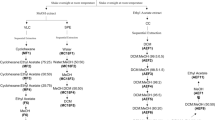Abstract
Several studies reported the antioxidant activity of bifidobacteria using assays in vitro. In present study, the in vitro and in vivo antioxidant activity of Bifidobacterium animalis 01 was investigated. Culture supernatant, intact cells, and intracellular cell-free extracts of B. animalis 01 were involved in this study. The antioxidant assays in vitro included lipid peroxidation assay, 1,1-diphenyl-2-picrylhydrazyl (DPPH) assay, hydroxyl radical (•OH) assay and superoxide anion (\( {\text{O}}_{2}^{ - } \)) assay. The antioxidant assays in vivo were conducted using mice model. Activities of antioxidative enzymes, malondialdehyde (MDA) content in serums and livers of aging mice were evaluated. Monoamine oxidase (MAO) activity and lipofuscin level in brains of aging mice were also characterized. Results showed that culture supernatant, intact cells and intracellular cell-free extracts of B. animalis 01 could effectively scavenge free radicals, significantly enhance mice’s activities of antioxidative enzymes and reduce mice’s MDA content, lipofuscin level and MAO activity. Our results indicated that B. animalis 01 has the potential to be developed into a dietary antioxidant supplements.
Similar content being viewed by others
References
Alper G, Girgin F, Ozgonol M, Mentes G, Ersoz B (1999) MAO inhibitors and oxidant stress in aging brain tissue. Eur Neuropsychopharmacol 9:247–252
Andaloussi SA, Talbaoui H, Marczak R, Bonaly R (1995) Isolation and characterization of exocellular polysaccharides produced by Bifidobacterium longum. Appl Microbiol Biotechnol 43:995–1000
Blois MS (2002) Antioxidant determinations by the use of a stable free radical. Nature 26:1199–1200
Bouhnik Y, Pochart P, Marteau P, Arlet G, Goderel I, Rambaud JC (1992) Fecal recovery in humans of viable Bifidobacterium sp. ingested in fermented milk. Gastroenterology 102:875–878
Buettner GR, Mason RP (1990) Spin-trapping methods for detecting superoxide and hydroxyl free radicals in vivo and in vitro. Methods Enzymol 186:127–133
Grossman S, Zakut R (1979) Determination of the activity of lipoxygenase (lipoxidase). Methods Biochem Anal 25:303–329
Jack RW, Tagg JR, Ray B (1995) Bacteriocins of Gram-positive bacteria. Microbiol Rev 59:171–200
Kim JY, Choi SI, Heo TR (2003) Screening of antioxidative activity of Bifidobacterium species isolated from Korean infants feces and their identification. Biotechnol Bioprocess Eng 8:199–204
Kohno M, Suzuki S, Kanaya T, Yoshino T, Matsuura Y, Asada M, Kitamura S (2009) Structural characterization of the extracellular polysaccharide produced by Bifidobacterium longum JBL05. Carbohydr Polym 77:351–357
Lin MY, Chang FJ (2000) Antioxidative effect of intestinal bacteria Bifidobacterium longum ATCC 15708 and Lactobacillus acidophilus ATCC 4356. Dig Dis Sci 45:1617–1622
Lin MY, Yen CL (1999) Inhibition of lipid peroxidation by Lactobacillus acidophilus and Bifidobacterium longum. J Agric Food Chem 47:3661–3664
Melov S, Ravenscroft J, Malik S, Gill MS, Walker DW, Clayton PE, Wallace DC, Malfroy B, Doctrow SR, Lithgow GJ (2000) Extension of life-span with superoxide dismutase/catalase mimetics. Science 289:1567–1569
Meghrous J, Euloge P, Junelles AM, Ballongue J, Petitdemange H (1990) Screening of Bifidobacterium strains for bacteriocin production. Biotechnol Lett 12:575–580
Mitsuoka T (1990) Bifidobacteria and their role in human health. J Ind Microbiol 6:263–268
Nicol S (1987) Some limitations on the use of the lipofuscin ageing techniques. Mar Biol 93:609–614
Saikali J, Picard C, Freitas M, Holt P (2004) Fermented milks, probiotic cultures, and colon cancer. Nutr Cancer 49:14–24
Sartor RB (2004) Therapeutic manipulation of the enteric microflora in inflammatory bowel diseases: antibiotics, probiotics, and prebiotics. Gastroenterology 126:1620–1633
Seifried HE, Anderson DE, Fisher EI, Milner JA (2007) A review of the interaction among dietary antioxidants and reactive oxygen species. J Nutr Biochem 18:567–579
Sharma D, Maurya AK, Singh R (1993) Age-related decline in multiple unit action potentials of CA3 region of rat hippocampus: correlation with lipid peroxidation and lipofuscin concentration and the effect of centrophenoxine. Neurobiol Aging 14:319–330
Shen Q, Zhang B, Xu R, Wang Y, Ding X, Li P (2010) Antioxidant activity in vitro of the selenium-contained protein from the Se-enriched Bifidobacterium animalis 01. Anaerobe 16:380–386
Tanas S, Odabasoglu F, Halici Z, Cakir A, Aygun H, Ali A, Suleyman H (2010) Evaluation of anti-inflammatory and antioxidant activities of Peltigera rufescens lichen species in acute and chronic inflammation models. J Nat Med 64:42–49
Valko M, Leibfritz D, Moncol J, Cronin MTD, Mazur M, Telser J (2007) Free radicals and antioxidants in normal physiological functions and human disease. Int J Biochem Cell B 39:44–84
Vernet M, Hunter JR, Vetter RD (1988) Accumulation of age-pigments 522 (lipofuscin) in two cold-water fishes. Fish Bull 86:401–407
Virtanen T, Pihlanto A, Akkanen S, Korhonen H (2007) Development of antioxidant activity in milk whey during fermentation with lactic acid bacteria. J Appl Microbiol 102:106–115
Wang YC, Yu RC, Chou CC (2006) Antioxidative activities of soymilk fermented with lactic acid bacteria and bifidobacteria. Food Microbiol 23:128–135
Yao DC, Shi WB, Gou YL, Zhou XR, Tak YA, Zhou YK (2005) Fatty acid mediated intracellular iron translocation: a synergistic mechanism of oxidative injury. Free Radic Bio Med 39:1385–1398
Yasui H, Kiyoshima J, Ushijima H (1995) Passive protection against rotavirus-induced diarrhea of mouse pups born to and nursed by dams fed Bifidobacterium breve YIT4064. J Infect Dis 172:403–409
Yildirim Z, Johnson MG (1998) Characterization and antimicrobial spectrum of bifidocin B, a bacteriocin produced by Bifidobacterium bifidum NCFB 1454. J Food Protect 61:47–51
Zang LY, Cosma G, Gardner H, Vallyathan V (1998) Scavenging of reactive oxygen species by melatonin. Biochim Biophys Acta 1425:469–477
Acknowledgments
This research was funded by China National 863 Program (2008AA10Z324) and Beijing Natural Science Foundation (5072025).
Author information
Authors and Affiliations
Corresponding author
Additional information
Authors Qian Shen, Nan Shang equally contributed to this work.
Rights and permissions
About this article
Cite this article
Shen, Q., Shang, N. & Li, P. In Vitro and In Vivo Antioxidant Activity of Bifidobacterium animalis 01 Isolated from Centenarians. Curr Microbiol 62, 1097–1103 (2011). https://doi.org/10.1007/s00284-010-9827-7
Received:
Accepted:
Published:
Issue Date:
DOI: https://doi.org/10.1007/s00284-010-9827-7




